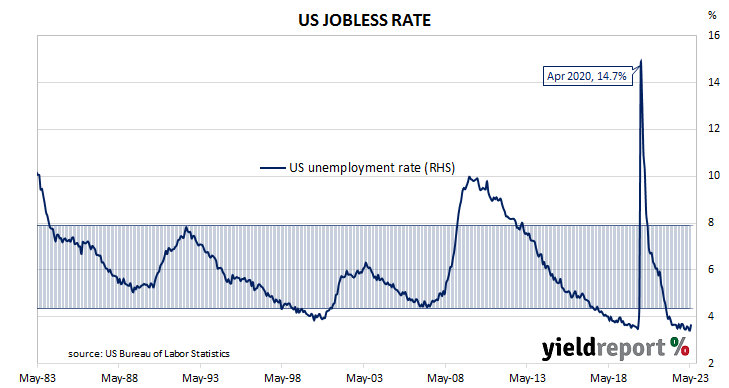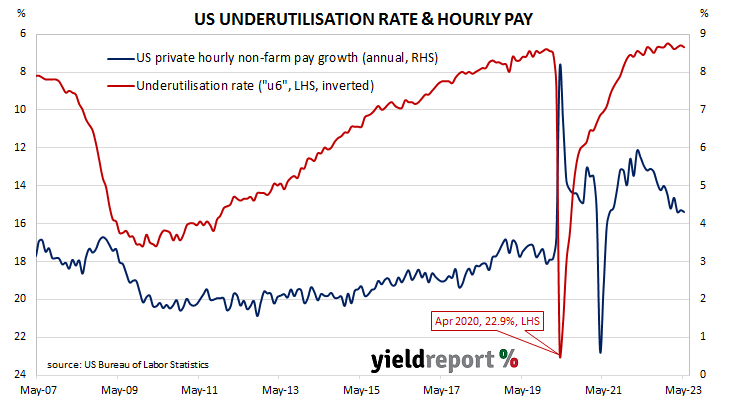Summary: Non-farm payrolls up 339,000 in May, greater than expected; previous two months’ figures revised up by 93,000; jobless rate up from 3.4% to 3.7%, participation rate steady; NAB: labour market remains in “rude health”; employed-to-population ratio slips; underutilisation rate up; annual hourly pay growth slows to 4.3%.
The US economy ceased producing jobs in net terms as infection controls began to be implemented in March 2020. The unemployment rate had been around 3.5% but that changed as job losses began to surge through March and April of 2020. The May 2020 non-farm employment report represented a turning point and subsequent months provided substantial employment gains. Changes in recent months have been generally more modest but still above the average of the last decade.
According to the US Bureau of Labor Statistics, the US economy created an additional 339,000 jobs in the non-farm sector in May. The increase was nearly double the 180,000 which had been generally expected and greater than the 294,000 jobs which had been added in April after revisions. Employment figures for March and April were revised up by a total of 93,000.
The total number of unemployed increased by 440,000 to 6.097 million while the total number of people who were either employed or looking for work increased by 130,000 to 166.818 million. These changes led to the US unemployment rate rising from April’s figure of 3.4% to 3.7% as the participation rate remained steady at 62.6%. “The better-than-expected payrolls number…plus 90,000 of upwards revisions to the previous two months suggests the US labour market remains in rude health,” said NAB senior FX strategist Rodrigo Catril.
US Treasury yields rose noticeably on the day, especially at the front of the yield curve. By the close of business, the 2-year yield had jumped 17bps to 4.51%, the 10-year yield had added 9bps to 3.70% while the 30-year yield finished 5bps higher at 3.88%.
In terms of US Fed policy, expectations of lower federal funds rates in 2024 softened. At the close of business, contracts implied the effective federal funds rate would average 5.125% in June, 5bps higher than the current spot rate, and then move up to average 5.18% in July. September futures contracts implied a 5.285% average effective federal funds rate while May 2024 contracts implied 4.385%, 69bps less than the current rate.
One figure which is indicative of the “spare capacity” of the US employment market is the employment-to-population ratio. This ratio is simply the number of people in work divided by the total US population. It hit a cyclical-low of 58.2 in October 2010 before slowly recovering to just above 61% in late-2019. May’s reading declined from 60.4% to 60.3%, some way from the April 2000 peak reading of 64.7%.
Apart from the unemployment rate, another measure of tightness in the labour market is the underutilisation rate and the latest reading of it registered 6.7%, up from 6.6% in April. Wage inflation and the underutilisation rate usually have an inverse relationship and hourly pay growth in the year to May slowed from 4.4% to 4.3%.



